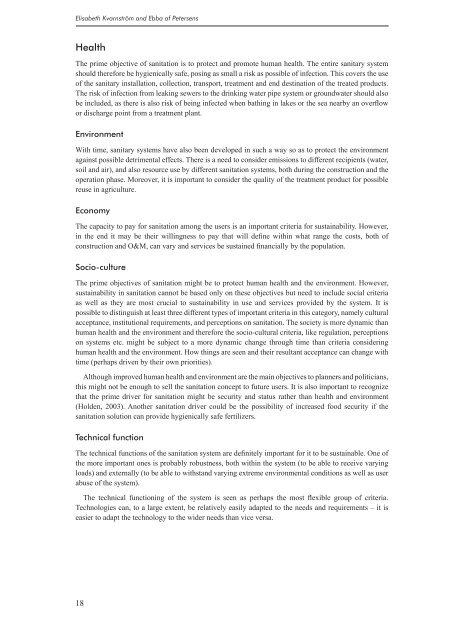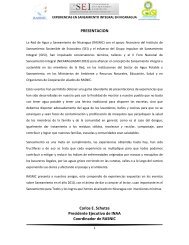Open Planning of Sanitation Systems
Open Planning of Sanitation Systems
Open Planning of Sanitation Systems
Create successful ePaper yourself
Turn your PDF publications into a flip-book with our unique Google optimized e-Paper software.
Elisabeth Kvarnström and Ebba af PetersensHealthThe prime objective <strong>of</strong> sanitation is to protect and promote human health. The entire sanitary systemshould therefore be hygienically safe, posing as small a risk as possible <strong>of</strong> infection. This covers the use<strong>of</strong> the sanitary installation, collection, transport, treatment and end destination <strong>of</strong> the treated products.The risk <strong>of</strong> infection from leaking sewers to the drinking water pipe system or groundwater should alsobe included, as there is also risk <strong>of</strong> being infected when bathing in lakes or the sea nearby an overflowor discharge point from a treatment plant.EnvironmentWith time, sanitary systems have also been developed in such a way so as to protect the environmentagainst possible detrimental effects. There is a need to consider emissions to different recipients (water,soil and air), and also resource use by different sanitation systems, both during the construction and theoperation phase. Moreover, it is important to consider the quality <strong>of</strong> the treatment product for possiblereuse in agriculture.EconomyThe capacity to pay for sanitation among the users is an important criteria for sustainability. However,in the end it may be their willingness to pay that will define within what range the costs, both <strong>of</strong>construction and O&M, can vary and services be sustained financially by the population.Socio-cultureThe prime objectives <strong>of</strong> sanitation might be to protect human health and the environment. However,sustainability in sanitation cannot be based only on these objectives but need to include social criteriaas well as they are most crucial to sustainability in use and services provided by the system. It ispossible to distinguish at least three different types <strong>of</strong> important criteria in this category, namely culturalacceptance, institutional requirements, and perceptions on sanitation. The society is more dynamic thanhuman health and the environment and therefore the socio-cultural criteria, like regulation, perceptionson systems etc. might be subject to a more dynamic change through time than criteria consideringhuman health and the environment. How things are seen and their resultant acceptance can change withtime (perhaps driven by their own priorities).Although improved human health and environment are the main objectives to planners and politicians,this might not be enough to sell the sanitation concept to future users. It is also important to recognizethat the prime driver for sanitation might be security and status rather than health and environment(Holden, 2003). Another sanitation driver could be the possibility <strong>of</strong> increased food security if thesanitation solution can provide hygienically safe fertilizers.Technical functionThe technical functions <strong>of</strong> the sanitation system are definitely important for it to be sustainable. One <strong>of</strong>the more important ones is probably robustness, both within the system (to be able to receive varyingloads) and externally (to be able to withstand varying extreme environmental conditions as well as userabuse <strong>of</strong> the system).The technical functioning <strong>of</strong> the system is seen as perhaps the most flexible group <strong>of</strong> criteria.Technologies can, to a large extent, be relatively easily adapted to the needs and requirements – it iseasier to adapt the technology to the wider needs than vice versa.18



![Project Document [PDF: 2.31 MB] - EcoSanRes](https://img.yumpu.com/51279385/1/184x260/project-document-pdf-231-mb-ecosanres.jpg?quality=85)












![Latrines à compost [high-resolution colour PDF: 12.3MB] - EcoSanRes](https://img.yumpu.com/31726141/1/185x260/latrines-a-compost-high-resolution-colour-pdf-123mb-ecosanres.jpg?quality=85)